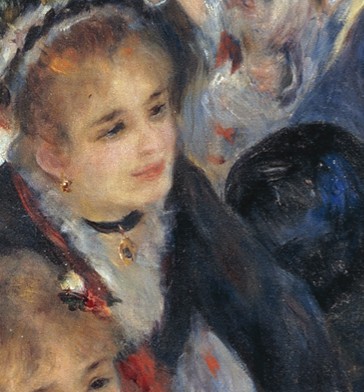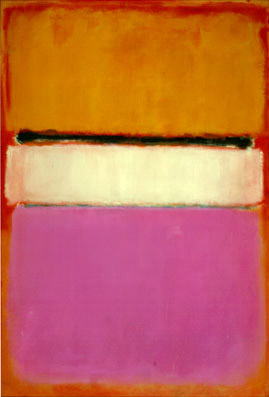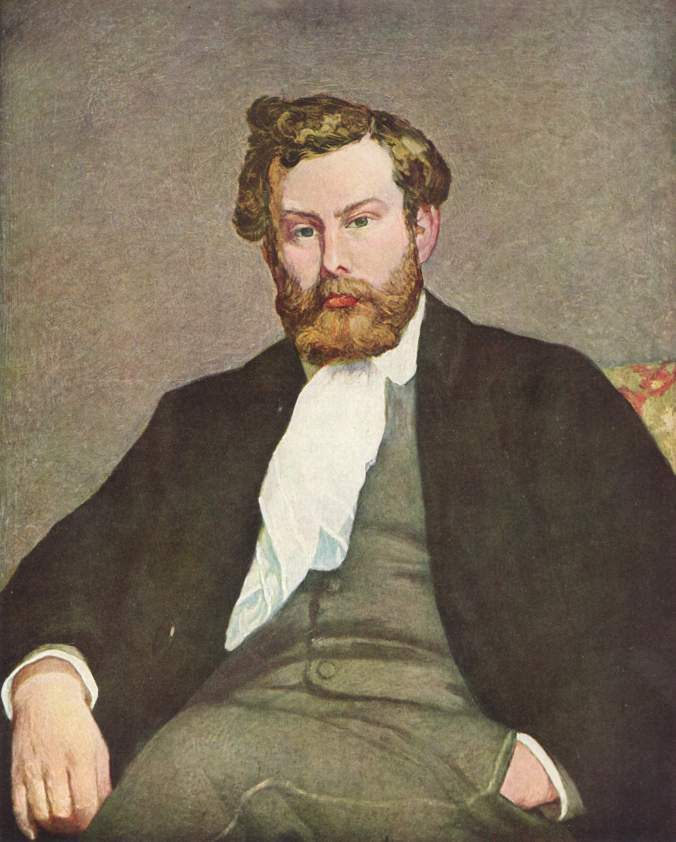 The 1876 4’4” by 5’9” oil on canvas ‘Le Moulin de la Galette’ is one of Pierre-Auguste Renoir’s most popular and impressive paintings, and a fine example of his early impressionist era. It demonstrates many of the aims, qualities and techniques of impressionist painting.
The 1876 4’4” by 5’9” oil on canvas ‘Le Moulin de la Galette’ is one of Pierre-Auguste Renoir’s most popular and impressive paintings, and a fine example of his early impressionist era. It demonstrates many of the aims, qualities and techniques of impressionist painting.
Though regularly portraying beautiful and happy scenes (Renoir famously said “Why shouldn’t art be pretty? There are enough unpleasant things in the world.”), nineteenth century impressionism was a radical departure from the prevailing French academy. The preserver of French art standards, the academy promoted historical and religious subjects, with still lifes and landscapes ranked low. The academy valued formally composed scenes, made with careful and preferably invisible brushstrokes that made the image look realistic even upon close inspection. The figures were to be clearly defined and the colors were expected to be restrained and often toned down by varnish.

Pollice Verso (1872) Jean-Léon Gérôme. An example of the highly detailed, ‘stuck in time’ style preferred by the French Academy.
Influenced by, amongst others, Delacroix, the experimental brushwork and spontaneous landscapes of Constable and Turner, the outdoors scenes of the Barbizon school and the colorful and candidly composed Japanese ukiyo-prints, Renoir and fellow impressionists wanted to paint different than academic subjects with different looks. They wanted to paint fresh landscapes, normal people in normal, happy, brightly colored situations. They skipped historical and mythical subjects for contemporary life. Most importantly they wanted a new, spontaneous, realistic way of depicting at the world, reflecting the impressionistic way humans really see the ever changing visual information in front of their eyes. They loved and wanted to portray the ephemeral nature of the world, movement, the changing plays of light, color and shadows on a scene, how light filters through fluttering leaves and dances on the subjects.
Despite the academic standards, the world isn’t frozen in time. Human visual perception involves processing ever changing, limited and ambiguous visual information. The human eyes don’t see everything in focus. We focus on some information, see other information only in the periphery. We get hints of things, vague shapes of things. Far away objects are shadowed and missing detail. We take a second look at things that catch our peripheral attention and they have changed. Light fleetingly shines off a distant shard of glass.
 In fact, such qualities as color, blurriness, angle, balance and placement are an essential and integral part of how we judge things such as distance and movement. In the real world, a quickly moving object will be blurred, a distant object will be shadowy or a different color and out of focus. You can’t read a book page being moved about. You have to hold it still and close. Impressionism more closely resembles real perception, and not the then French academic standard of everything in perfect detail and frozen in time. The academic standard of showing a scene of movement but having everything in perfect detail is oxymoronic. That’s a fiction, not the way things really work with human eyes.
In fact, such qualities as color, blurriness, angle, balance and placement are an essential and integral part of how we judge things such as distance and movement. In the real world, a quickly moving object will be blurred, a distant object will be shadowy or a different color and out of focus. You can’t read a book page being moved about. You have to hold it still and close. Impressionism more closely resembles real perception, and not the then French academic standard of everything in perfect detail and frozen in time. The academic standard of showing a scene of movement but having everything in perfect detail is oxymoronic. That’s a fiction, not the way things really work with human eyes.
The eyes detect only a limited range of light, and cognitive psychology shows how humans perceive– or make judgment of identify, movement and qualities– subconsciously and automatically from this limited and often ambiguous information. We don’t need to see a perfectly detailed horse on a distant hill to identify it is a horse. From context, movement, general shape and our memories, we can identify a distant horse, plane or bird. We certainly can’t make out the feathers, eyes and beak on a crow flying in the distance, but we can identify it as a crow.
Further, our automatic interpretation and perception of visual information isn’t just about physical identification. It also involves emotional, aesthetic and even moral perception and judgments. Colors, shapes, composition, blurriness, patterns of light and dark not only allow us to perceive identity, size, distance and movement, but give us emotional and often artistic reactions. We find the spots of light on the people in Le Moulin de la Galette to be beautiful. We love the fresh colors and the natural composition.

Mark Rothko
Prominent University College London neurobiologist Semi Zeki said that great artists were neuroscientists even if they didn’t realize it. He said that artists played with shapes, colors and tones, angles, arrangement and other qualities to elicit perceptions and emotions in the audience. The impressionists showed what basic information was needed for the viewer to make perceptions, and pointed the path to future perceptual and informational experiments, including post-impressionism, cubism, abstract painting and Op art. We can see the impressionists influence on everyone from Cezanne to Picasso to Mark Rothko.
The impressionists had a shared interest in painting landscapes and contemporary daily life and, unusually, painted outdoors– not just the preliminary sketches as with John Constable, but the entire paintings. This required quick work and focusing on the essentials, which went hand in hand with the impressionist view of things.
The natural broad impasto nature of brushwork was conducive to impressionism. Far from trying to hide the brushstrokes as the academy wanted, the impressionists used the broadness and impasto to its advantage. The solid colors, blocks and dabs of color, vague shapes helped mimicked the impressionistic way people viewed the world.
Along with using short, thin, clearly visible brushstrokes, they did not clearly define the borders of the figures and objects. The borders are blurred. In some of Renoir’s paintings, it is hard to tell where a figure ends and another begins.
Color was an essential part of impressionism. Influenced by new scientific color theories from chemists and physicists, Renoir and the impressionists experimented with color and color application. The impressionists discovered that putting colors side by side, instead of mixing them together, gave different color and visual effects. They created the perception of gray not by making gray paint but by laying side by side complimentary non-gray colors that created the illusion. They also painted on a light background to make their images brighter. Monet’s ‘Impression, Sunrise’ places side by side the complementary blue and orange in the sky to give a glowing effect. The side by side color effects, picked up by the eyes but often blurred together from a distance, is best exemplified by the later pointillist works of Georges Seurat.

Renoir’s 1883 Children at the Beach

detail of a Georges Seurat pointallism painting
Friends who often painted together outdoors, Renoir and Monet, further learned that shadows aren’t brown and black as commonly portrayed in art, but a reflection of the color of the object creating the shadow. For example, shadows on snow are usually blue. A critic specifically noted that the shadow on the face Renoir’s The Blue Lady was green. Impressionists avoided black paint, in part because they discovered that it rarely exists in the natural world.

Snow with blue shadows by Monet
Their experiments in color and brushwork were enhanced by new paints. Paints were introduced in already mixed tubes, so they could more easily paint outdoors. Before, artists had to mix their colors themselves. Also, new and often striking colors, such as cobalt blue, were introduced and first used by the impressionists. It caused a bit of a sensation when Manet first used cobalt blue in a painting.
 Photography was a profound influence on impressionism. Wishing to depict real life scenes, impressionism often mimics snapshot photos, with natural, unposed and unbalanced compositions, people in natural, candid positions, photographic-like angles and figures cropped at the borders. Though Le Moulin de la Galette was composed with Renoir’s friends as models and is a carefully assembled series of portraits, it much resembles a photograph. It resembles a snapshot of real people unaware they are being photographed. As with a snapshot, we see this as a cropped image from a larger scene, some people not entirely making it into the shot.
Photography was a profound influence on impressionism. Wishing to depict real life scenes, impressionism often mimics snapshot photos, with natural, unposed and unbalanced compositions, people in natural, candid positions, photographic-like angles and figures cropped at the borders. Though Le Moulin de la Galette was composed with Renoir’s friends as models and is a carefully assembled series of portraits, it much resembles a photograph. It resembles a snapshot of real people unaware they are being photographed. As with a snapshot, we see this as a cropped image from a larger scene, some people not entirely making it into the shot.
Further, 1800s photography revealed the impressionist, subjective view of physical reality, In photographs, some things are in focus, others are not. There are levels of visual depth and focus. Light and shadow cast upon the figures, sometimes hindering identification, sometimes creating exquisite artistic effects. Photographers were (and are) regularly surprised at how the final photograph turns out. Further, photography showed that many human ideas about reality as expressed throughout the centuries in art were wrong, The most famous example is that photography showed that standard artistic portrayal of a horse’s legs positions during galloping was incorrect. Horses aren’t positioned like rocking horses when running.
It is noteworthy that fellow impressionist Degas was an avid photographer and photo collector. His paintings have a snapshot look, in the compositions, angles and that the people are portrayed in natural, candid poses.

A Degas painting with several photo qualities, including angle, cropping and snapshot-like action.
Renoir came from a poor background and was often the proverbial starving artist, and Le Moulin de la Galette shows fellow middle and working class people on their time off. It celebrates their lives and shows the joy and fun it could contain. Along with his other paintings, it showed that he loved life and the beauty of ordinary life. His paintings are filled with friends, lovers and family. Wanting to portray movement and the way people really view the world was both aesthetic and philosophical. Much as with John Constable, he saw beauty in the world as he saw it, not is some idyllic academic contrivance.
As noted in the beginning, Le Moulin de la Galette is an example of Renoir’s early impressionist period. Renoir went through several periods, both outside of and variations within impressionism.
His works from the 1860s most fit the academy’s definition of art, with mythological-like subjects, clear definition, formal composition and fine detailing. By the 1870s, he had entered into his early impressionist period as exemplified by Le Moulin de la Galette. An 1881 trip to Italy with a viewing of the Renaissance masters, especially Raphael, made him change his approach. He left impressionism and returned to a more formal and disciplined style, though retained the bright colors. He later returned to impressionism, but in different and changing forms and subjects than his original impressionistic style. He used the same color techniques, but the subjects were more formal and clearly defined. His final period uniquely combined the formal traditions of the Renaissance with the impressionist colors and brushwork.

An 1866 Renoir, before impressionism.
Today Le Moulin de la Galette is valued for its aesthetic appeal: a fresh, spontaneous, joyful look at Parisian life. It is valued as one of the most impressive of his works. It looks fresh and candid, yet is a complex image with many ‘moving parts.’ It is valued for its theoretical experiments of color and perception, and as a historical step towards later modern art. Neuroscientists, such as Semir Zeki, actively study how impressionism and other artistic techniques affect the mind and human perception. Looking at how we perceive reality shows us how we perceive art, and looking at how we perceive art helps show us how we perceive reality. I even found a website teaching web design that discussed how the color theories used by impressionists should be used by web designers to make websites more user friendly.
References:
Zatista.com article on color theory
Designforhackers.com article on impressionist color theory
WIkipedia articles on Renoir, Le Moulin de la Galette, neuroaesthetics, Semir Zeki, The Blue Lady
Artble article on Renoir’s technique and style